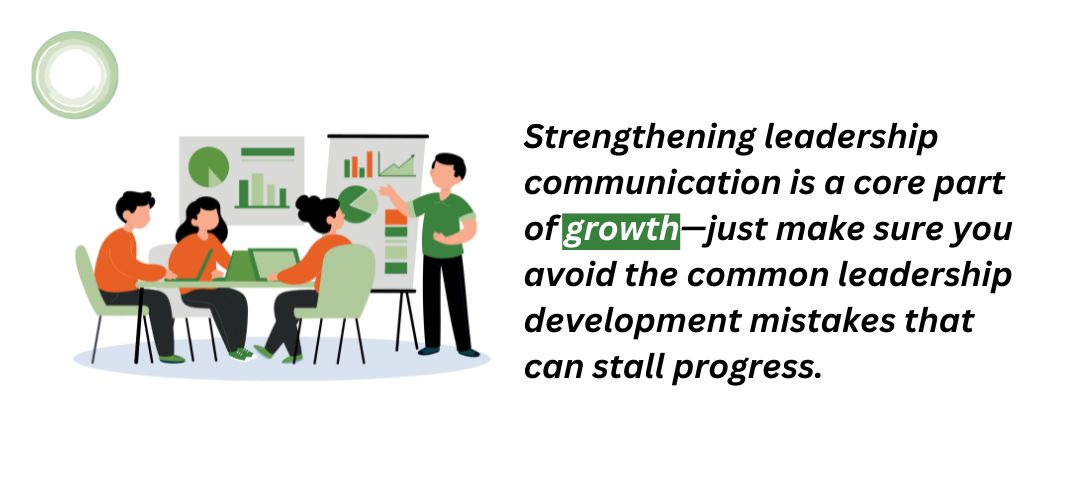When I say the words “executive presence” which leader comes to mind that most exemplifies this for you?
Have you ever wondered how you could develop executive presence and grow your impact as a leader?
If you’re nodding along, keep reading. We’re going to walk you through three aspects of executive presence + how to develop them.
Want to develop executive presence in your organization with expert guidance? Book a leadership demo and see how our executive coaching programs can support your goals.
1. Mastering Clarity to Strengthen Your Executive Presence
Nobody likes confusing directions, meetings that run long or guidance that’s hard to follow. Increase your executive presence by strengthening your executive communication skills — especially around setting clear expectations upfront.
Make your intentions clear + make sure you’re easy to follow.
Many times I see executives speak on a topic and I think to myself, “What is the purpose of their communication? What am I listening for? Do they want my feedback on something specific? Are they asking for a decision? What do I need to pay attention to?”
Want to sharpen your communication skills with a framework built for executives? Explore our Leadership EDGE course for tools that build clarity and influence.
When people don’t know what to listen for, their minds are more likely to wander.
These days I nip this in the bud. When one of my C-suite clients starts a diatribe, I’ll stop them and say, “Tell me what I’m listening for, so I’ll know what to pay attention to.”
It’s surprisingly easy to make your intentions clear — just share the outcome of what you’re hoping to achieve upfront.
Instead of starting with “Here’s what happened…” say “I’d like to get your opinion on how I should handle a conflict on my team, so I’ll start with some context. Here’s what happened…”
See how much clearer that is? And you’re much more likely to get the outcome and support you need!
Be explicit about your expectations + what you’re asking for.
Again, just tell your people what you want. Right there in the presentation slides or in the meeting agenda or at the top of the conversation lay out your goals and expectations.
Those with strong executive presence practice effective leadership communication — laying out goals in a clear, concise way and directing the conversation the way they need it to go to achieve the result.
If you’re looking to improve leadership communication skills across your team, schedule a demo to learn about our targeted coaching and training programs.
Strengthening leadership communication is a core part of growth—just make sure you avoid the common leadership development mistakes that can stall progress.

2. Leadership Authority: The Role of Trust and Intention in Influence
Authority isn’t about speaking in a loud voice and name dropping all the conferences you’ve keynoted. True authority comes from the ability to build trust in leadership — rooted in consistency, clarity, and intention. Does your team trust your competence, reliability and intention?
Find the authority from your intention, rather than leaning into your role or position.
Nobody appreciates when someone “pulls rank” or plays the “because I’m your boss” card. Instead, reference the intention behind your ask. If you need someone to work late on the new product launch, remind them of all the customers whose lives will be improved by this new product (rather than saying “Because I told you so”).
Shift away from traditional egoistic drives (being right, looking good) and into a meaningful “mission” outside of your ego-based needs.
Leaders are successful when their teams are successful. But it’s hard for a team to be successful when they’re brow-beaten by an executive with a “my way or the highway” approach. And it’s hard for a team to do their best work for a leader who is only concerned about how they look to others. I can always tell when a leader is truly committed to the mission — or more committed to looking good, being right or being in control.
Focus on the mission — a hallmark of authentic leadership — and how it impacts your company, clients, and other stakeholders. What’s in it for them? Put your attention there, and your communication will have the integrity and earned authority that exudes executive presence.
Ready to build trust-based leadership authority in your organization? Explore our executive coaching solutions and how they align with your mission-driven leadership goals.
3. Building Confidence in Leadership Through Executive Communication Skills
Confidence isn’t just good posture. True confidence is a combination of strength and warmth that brings people in and builds connections. In other words, it makes everyone around you feel at ease by your strength (“I know where to go”) and warmth (“I respect and care for you”).

As an executive, there are many ways to demonstrate confidence in leadership and sharpen your executive communication skills. You demonstrate confidence in speed of decision making, asking tough questions, admitting vulnerabilities. But let’s talk about how to showcase your confidence in conferences, meetings or presentation situations, as that’s where lack of confidence is most on display.
Public speaking can shake the confidence of even experienced professionals. Building public speaking confidence is essential to executive presence. Here’s the trick:
Move your attention away from your inner critic (that voice inside your head) to connecting with your audience.
This was one of the best things I learned from my post-graduate degree in acting from LAMDA (London Academy of Music and Dramatic Arts).
Rather than obsessing about how you look standing in front of people (What do I do with my hands?) or the typo in that slide, focus on how much the audience is learning from this presentation. Focus on what you think they need or how this information will shift their thinking.
To help you remember this in moments of stress: When in doubt, focus OUT.
And if you can use this method in a presentation setting, you can use it in a 1:1 setting as well!
Communicate confidence with the right pacing, vocal variety and gestures.
You know an unconfident speaker when you hear one. Maybe they mumble and rush through their presentation or speak in a monotone the entire time. Maybe they’ve got one go-to gesture that they repeat every time they want to make a point.
None of these things communicate confidence to the audience. If you’re not sure how you come across, ask someone to record a video of your next presentation.
Take a look at it and be honest with yourself. Where could you speed things up or slow them down? Could you lower or raise your voice for emphasis? What gestures could you introduce other than those air quotes you use all the time? People crave vocal variety — it’s a subtle but essential piece of leadership communication that keeps your message impactful.
Increasing your executive presence isn’t something that will happen overnight but, with some time and effort, it’s absolutely achievable.
Ready to Develop Executive Presence and Strengthen Leadership Communication?
If you’re looking to enhance executive presence across your senior leadership team, we offer proven frameworks, executive coaching, and leadership communication training designed to elevate your influence and impact. Our workshops include hands-on video practice and tailored feedback to help leaders build clarity, authority, and confidence.
Get in touch to explore how we can support your leadership development goals.


